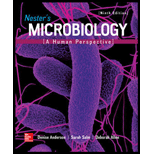
Concept explainers
To review:
The sign that differentiates pneumococcal meningitis from meningococcal meningitis.
Introduction:
Meningococcal meningitis is caused by the organism Neisseria meningitides, which is a Gram-negative, diplococcus, and encapsulated bacteria. The infection caused by the Streptococcus pneumoniae leads to sinusitis, otitis media, or pneumonia, which may lead to the development of pneumococcal meningitis. Both the species of organisms mentioned are one of the most common species’ that causes meningitis.
Explanation of Solution
The pneumococcal meningitis is caused by the Streptococcus pneumonia, which is usually a part of the normal microbiota of the nasopharynx and throat. This disease usually initiates like a mild cold. This is then followed by a sudden severe headache. On the other hand, the symptoms of meningococcal meningitis begin appearing after 1–7 days. The symptoms of both the diseases are similar except that meningococcal meningitis includes purplish spots on the skin surface of the affected individual.
The purplish spots produced as the symptom of meningococcal disease are called petechiae. These are caused because of the bleeding beneath the skin surface, which results from the capillary damage. The capillary damage is caused by Neisseria meningitidis, which is a causative organism of the disease.
It is important to distinguish the two diseases because meningococcal meningitidis is difficult to eliminate comparatively. This is because the causative agent of this disease which is Neisseria meningitidis is a part of the normal respiratory tract.
Therefore, the presence of petechiae (purplish spots) in the meningococcal meningitidis is the sign that distinguishes it from pneumococcal meningitidis.
Want to see more full solutions like this?
Chapter 26 Solutions
Nester's Microbiology: A Human Perspective
- What is the definition of Meningitis?arrow_forward1)Explain how the body (including cells, organs, and organ systems) is affected by meningococcal meningitis? 2)Are there any long-term effects caused by meningococcal meningitis, even after recovery?arrow_forwardWhy does necrotizing fasciitis require immediate surgery?arrow_forward
 Human Anatomy & Physiology (11th Edition)BiologyISBN:9780134580999Author:Elaine N. Marieb, Katja N. HoehnPublisher:PEARSON
Human Anatomy & Physiology (11th Edition)BiologyISBN:9780134580999Author:Elaine N. Marieb, Katja N. HoehnPublisher:PEARSON Biology 2eBiologyISBN:9781947172517Author:Matthew Douglas, Jung Choi, Mary Ann ClarkPublisher:OpenStax
Biology 2eBiologyISBN:9781947172517Author:Matthew Douglas, Jung Choi, Mary Ann ClarkPublisher:OpenStax Anatomy & PhysiologyBiologyISBN:9781259398629Author:McKinley, Michael P., O'loughlin, Valerie Dean, Bidle, Theresa StouterPublisher:Mcgraw Hill Education,
Anatomy & PhysiologyBiologyISBN:9781259398629Author:McKinley, Michael P., O'loughlin, Valerie Dean, Bidle, Theresa StouterPublisher:Mcgraw Hill Education, Molecular Biology of the Cell (Sixth Edition)BiologyISBN:9780815344322Author:Bruce Alberts, Alexander D. Johnson, Julian Lewis, David Morgan, Martin Raff, Keith Roberts, Peter WalterPublisher:W. W. Norton & Company
Molecular Biology of the Cell (Sixth Edition)BiologyISBN:9780815344322Author:Bruce Alberts, Alexander D. Johnson, Julian Lewis, David Morgan, Martin Raff, Keith Roberts, Peter WalterPublisher:W. W. Norton & Company Laboratory Manual For Human Anatomy & PhysiologyBiologyISBN:9781260159363Author:Martin, Terry R., Prentice-craver, CynthiaPublisher:McGraw-Hill Publishing Co.
Laboratory Manual For Human Anatomy & PhysiologyBiologyISBN:9781260159363Author:Martin, Terry R., Prentice-craver, CynthiaPublisher:McGraw-Hill Publishing Co. Inquiry Into Life (16th Edition)BiologyISBN:9781260231700Author:Sylvia S. Mader, Michael WindelspechtPublisher:McGraw Hill Education
Inquiry Into Life (16th Edition)BiologyISBN:9781260231700Author:Sylvia S. Mader, Michael WindelspechtPublisher:McGraw Hill Education





